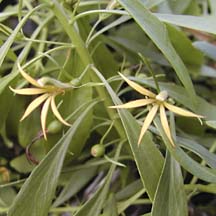
In the Garden![]()
Rick Barboza
HUI KU MAOLI OLA
Naupaka Kuahiwa
LATIN NAME
Scaevola gaudichaudii
Description: Small shrubs 3 to 4 feet tall with narrow leaves about 2 to 3 inches long and 1/2 to 1 inch wide. The leaves are slightly serrated near the tip. The most appealing feature of this native plant are its fragrant yellow "half flowers." Compared to the other eight native species of naupaka, six of which are also mountain dwelling, this species has the most striking narrow and pointed petals of them all. (The other two species are the common coastal naupaka kahakai, Scaevola sericea, and the Endangered dwarf naupaka, Scaevola coriacea, which is also found near the ocean.)
The color of the Naupaka kuahiwi or Mountain Naupaka flower is also unusual. It is only one of two yellow-flowered species of naupaka, the other being 'ohe naupaka, Scaevola glabra, which is extremely rare, found only in the upper-elevation wet forests of the Oahu's Ko'olau Mountains, and on Kauai. The Scaevola glabra's yellow flowers are more similar to that of a native lobelia than a naupaka.
Once the flowers are pollinated, small black fruit develop, each containing a single seed.
Distribution: This endemic species is found on all the main islands except Niihau and Kahoolawe in the dry to mesic forests, quite unlike its other mountain naupaka relatives which reside mostly in higher, wetter areas.
Landscape use and care: This plant makes an excellent addition to any yard, whether you're a collector of native plants or not. They require very little water once established in the ground and love full sun. They also seem to be the hardiest of the other species of naupaka kuahiwi, demonstrating resistance to the mites and pests that would normally cause leaves to appear crinkled and deformed.
Gardeners often plant coastal naupaka kahakai on the makai side of the house and naupaka kuahiwi on the mauka side.
Cultural uses: The fragrant flowers of various naupaka kuahiwi are used in lei as seen in the new book "Na Lei Makamae" by Marie McDonald and Paul Weissich. The book is a must-have for hula dancers, native plant collectors, lei makers and Hawaiian culture enthusiasts.
Also: The nine species of native naupaka are believed to have come from only three separate colonies. All but one species is endemic; the common coastal naupaka (S. sericea) is indigenous, and represents one of the three colonies. Because its fruit floats, it probably arrived from other Pacific habitats on numerous occasions. The other colony is believed to be for 'ohe naupaka, and the third represents the rest of the other species in which one pioneer branched ofd into many other species.
Gardening Calendar


